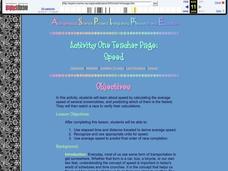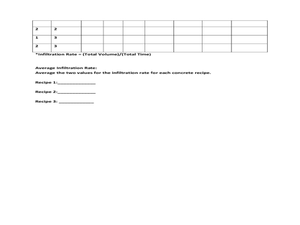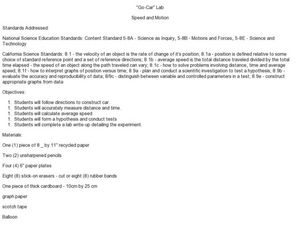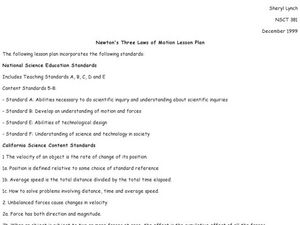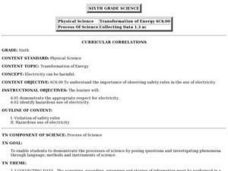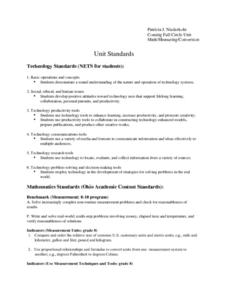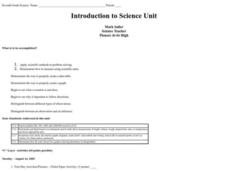Curated OER
Use Google Maps to Teach Math
Capture the engagement of young mathematicians with this upper-elementary math lesson on measuring time and distance. Using Google Maps, learners first measure and compare the distance and time it takes to travel between different...
Curated OER
Time Zones in the United States
Eighth graders explore how to use the time zones in the United States and internationally. They use elapsed time to solve problems. Students calculate the time in various places in the United States. They discuss the 6 time zones in the...
Curated OER
Not Your Average Average
Students discover that if a distance is traveled in two or more segments at different average speeds, you cannot average the average speeds. Instead the total distance traveled must be divided by the total elapsed time. Students practice...
Curated OER
Timing the Transit of Venus
Middle schoolers calculate elapsed time and look for patterns.
Curated OER
How Can we Measure the Rate of a Chemical Reaction?
Young scholars examine different types of chemical reactions. They explore how alcohol molecules affect the reaction rates. They answer discussion questions to end the lesson.
Curated OER
Travel Time
Pupils use a migration map to estimate the distance traveled by a bird while migrating south. After calculating accurate estimates of the distance traveled, students compare the distances traveled with the amount of time elapsed.
Curated OER
Speed
Students explore speed by calculating the average speed of several snowmobiles, and predicting which of them is the fastest. They watch a race to verify their calculations.
Virginia Department of Education
Weathering of Limestone
We all know limestone weathers, but what affects the rate of weathering? Young scientists investigate the physical and chemical weathering of limestone (chalk) through experimentation. First, they conduct trials with different-size...
Curated OER
Data Analysis: Infiltration Rate and Composition of Concrete
Learners collect and graph data. In this statistics lesson, students analyze data using a spreadsheet program. They display their data effectively and analyze it.
Curated OER
Introduction to Earning Interest: What are APR and APY?
Students explore saving and investing money. In this middle school personal finance instructional activity, students define and use investment vocabulary, explore compound interest and its effect of savings, and compute simple and...
Curated OER
"Go-Car" Lab
Learners construct a car based on directions given. In this physics lesson, students calculate average speed using distance and time information. They collect data and create a graph of distance vs. time.
Curated OER
How Fast Is Fast?
Students make sensible estimates and check the reasonableness of the answers. Students write and solve problems involving decimal multiplication and division. Students perform calculations with time.
Illustrative Mathematics
Logistic Growth Model, Abstract Version
Here learners get to flex some serious algebraic muscles through an investigation of logistic growth. The properties of the constant terms in the logistic growth formula are unraveled in a short but content-dense activity. Moving...
Curated OER
Extreme Acceleration
Learners explore the concept of acceleration. They determine the acceleration rate of a roller-blader and graph the results.
Curated OER
Newton's Three Laws of Motion Lesson Plan
Students explore Newton's three laws of motion using a variety of activities. In this physics lesson, students calculate the average speed of a vehicle they constructed using distance and time information. They identify and draw the...
Curated OER
Ratio and Proportion
Students explore ratios and proportions. For this ratios lesson, students work in groups to identify the ratio of boys to girls, as well as the ratio of vowels to consonants in their names. Given a bag of candy, students work in groups...
Curated OER
Electricity and Safety
Sixth graders investigate the importance of observing safety rules in the use of electricity. They discuss electricity safety rules, observe a power company employee read a meter, write and perform a commercial about electrical safety,...
Curated OER
Skeletal System
Seventh graders identify and label twenty-five bones of the skeletal system. In small groups they glue various types of dried pasta to a large human body outline. They attach the pasta to the outline and label the pasta bones.
Curated OER
Heredity, Genetics, Traits
Eighth graders study how an embryo develops into a fetus by undergoing many physical changes which they observe on a poster. They examine the metamorphosis of fruit flies as they develop through a series of changes. They record the...
Curated OER
Respiratory System
Students identify the parts of the respiratory system and how they interact. They define vocabulary words and draw an outline of themselves and label the parts of the respiratory system. They distinguish between healthy and unhealthy...
Curated OER
Metric Olympics
Students participate in a Metric Olympics event and use metric measurements to measure actual performances in their events. They throw a plastic straw for a javelin event, participate in a long jump and high jump event, and a variety of...
Curated OER
Introduction to Science
Seventh graders investigate scientific methods to solve problems. They demonstrate creating data tables and graphs. They study the role of a scientist and the importance of safety in a science lab. They distinguish between an...
Curated OER
Date a Rock!
Learners figure the number of half-lives since the sample solidified, and therefore the "age" of the sample rocks.
Curated OER
There's a Volcano in my Backyard!
Students study Mount Ranier and its activity as a volcano. In this investigative lesson students locate cities around Mount Ranier and complete an activity.








